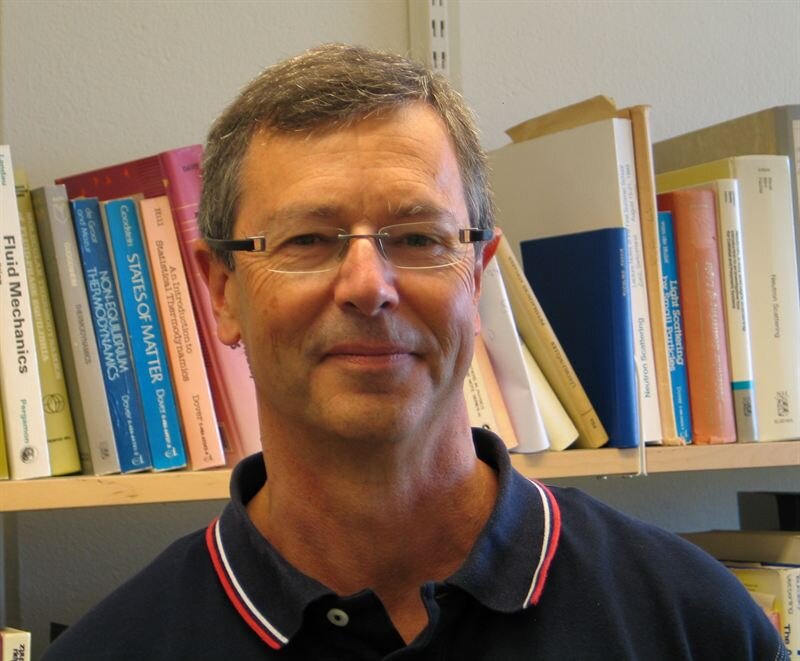“An outstanding feat for LINXS!”
Professor Peter Schurtenberger, founding Director of LINXS, comments on the news that the large-scale international research project, Dynamics of proteins in crowded environments on multiple length and time scales, has been awarded funding from the Swedish funding agency Vetenskapsrådet in the frame of a so-called Röntgen-Ångström Cluster.
Professor Peter Schurtenberger, founding Director of LINXS. Photo: Anna Stradner.
– For me, this is really a success story for LINXS. It demonstrates the potential that LINXS could have in bringing people together. We would not have been able to put it together if it were not for LINXS, and its networking opportunities, says Peter Schurtenberger.
The aim of the project is to develop research related to the technique XPCS (X-ray Photon Correlation Spectroscopy). XPCS uses coherent x-rays to provide experimental access to a variety of microscopic dynamic phenomena. If a random arrangement of scatterers is illuminated by coherent radiation, the scattered intensity exhibits a so-called speckle pattern that reflects the instantaneous configuration of the scatterers. Movement of the scatterers causes a corresponding change in the intensity of the different speckles, which allows researchers to study the dynamics of a system.
According to Peter Schurtenberger, who works at the Division of Physical Chemistry at Lund University, the grant is a direct result of the work within the working group Characterising Soft Matter with X-Ray Photon Correlation Spectroscopy – which was formed with the explicit aim to develop XPCS techniques. The working group was among the first research collaborations under the Dynamics theme.
– XPSC is different to other comparable techniques because you can measure motion of nanoparticles on small length scales. In the case of proteins, the distances you can measure actually correspond to the size of the protein, and how it moves until it encounters a neighboring protein. There is only one other method that allows us to measure protein motion in liquids in this way, and that is the so-called Neutron Spin Echo technique, which however can measure motion only on much shorter time scales. Therefore, XPCS is the only technique that could reveal slow motion of proteins in highly concentrated solutions on these length scales.
Peter Schurtenberger says that the technique has been around for quite some time, but that it has not been as successful as it could have been. This is because there are two major problems with using the technique in relation to soft materials. The first problem is that the intense x-rays that are needed to study the protein motion creates much damage on soft materials. The synchrotron light simply burns the soft material, and thus destroys the samples. The other problem is that the current detectors in the beamline are not fast enough to do XPCS with proteins.
– There are ways of overcoming these problems, and a lot of interest amongst researchers to develop working methods. LINXS afforded a setting for us to group our experience, come together and write the proposal.
The project will run for four years, starting in 2020. In Sweden, principal investigator Peter Schurtenberger will lead the work together with co-PI, Anna Stradner, professor in Physical Chemistry at Lund University, Ann Terry, researcher at MAX IV, and Fivos Perakis, assistant professor in the department of physics at Stockholm University. The international consortium also includes researches and research groups in Germany and France.
– We are pretty excited to take the next steps! Many people will now work together in different countries to further develop the potential of XPCS technique.
Research that can benefit many
– This research is important for many areas of science. We will get a better understanding of the cellular machinery, since we can study the motion of proteins in dense solutions on realistic length and time scales. For researchers in life science, this is invaluable knowledge.
The research results can also be of benefit to the pharmaceutical industry. A current trend is to develop drugs in higher concentrations as a way to avoid frequent injections and damage to the veins. But the more concentrated the drug is, the more likely it is to be too viscous, which makes it hard to inject.
– If we can apply knowledge of protein behavior, we can help the industry to develop better and more effective drug formulations.
Finally, the research project will also help the corresponding beamline CoSAXS, where a large part of the experiments will be carried out, to reach its full potential. CoSAXS is located at MAX IV.
– We hope that more researchers will start using the technique offered at the beamline and discover more uses of the XPSC technique.
Create a space where researchers want to spend time
When asked how LINXS could continue to support researchers to apply for grants and to develop their research, Peter Schurtenberger says that there are a number of things LINXS could do, for example work strategically to invite leading researchers to spend time at LINXS.
– As I see it, LINXS has to work proactively to make the change from hosting workshops and activities, to become a place where researchers chose to be. Workshops are of course very important; you meet people and present your ideas, but you cannot do new science there. The time is too short.
– I can see a great win-win situation in continuing to develop the visiting program. If we can get scientists to come here for an extended sabbatical, or just a couple of weeks, we have all the opportunities to create a great setting for new and exciting research. Here is where the LINXS management can come into the game, and make sure people are well selected and suited to visit LINXS, he concludes.

